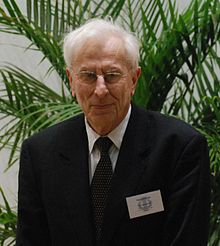Harald Rose (physicist)
Harald Rose (born February 14, 1935 in Bremen ) is a German physicist and university professor . He is known for his work on electron microscopy and received the Wolf Prize for Physics together with Knut Urban and Maximilian Haider .
Live and act
Harald Rose was born in February 1935 in Bremen as the son of the businessman Hermann Rose and his wife, Anna-Luise Rose. When he was two years old, his family moved to Darmstadt for professional reasons . He first attended elementary school and from 1946 the old secondary school (today: Georg-Büchner-Schule (Darmstadt) ). Since the school building was completely destroyed by a bomb attack on September 11, 1944, classes were held in shifts with other schools in the building of the Justus-Liebig-Schule in Lagerhausstrasse (today: Julius-Reiber-Strasse). After graduating from high school in 1955, he studied physics at the TH Darmstadt. He completed his intermediate diploma after just three semesters in May 1957. During his main studies, he was an assistant at Otto Scherzer . In his diploma thesis he dealt with questions of electron microscopy. In 1961, Rose finally completed his studies in physics. He then worked for Otto Scherzer. From this he received his doctorate in early 1965 with a topic in theoretical electron optics . In 1967 he received an assistant position in the Faculty of Mathematics and Physics. In February 1970 he completed his habilitation and received the venia legendi for physics. The title of his habilitation thesis was: Correction of electron microscopic lenses . Together with Otto Scherzer, he headed the theory group at the Institute for Applied Physics. This dealt with the problems of electron-optical imaging and the damage to electron microscopic objects by the imaging radiation (Scherzer 1977, p. 186). From 1976 to 1978 he was a Principal Research Scientist at the New York State Department of Health. From 1973 to 1974 he spent a research year at the Enrico-Fermi Institute at the University of Chicago and from 1995 to 1996 also a research year at Cornell and the University of Maryland . From 1980 until his retirement in 2000 he worked at the TU Darmstadt in the physics department.
At the end of the 1980s Rose calculated a correction system for the critical error of electromagnetic lenses, the so-called aberration, which is particularly detrimental to resolution. The groundbreaking thing about it is that the classic round electron lens is combined with non-round elements that correct the ametropia like “glasses”, so that a largely flawless overall optical system is created. Rose presented his ideas in 1989 at an international conference at which Knut Urban and Maximilian Haider were also present. In the 1990s, Harald Rose and his colleagues (especially Maximilian Haider) and Knut Urban from Forschungszentrum Jülich achieved a breakthrough in the field of electron microscopy as part of a research project funded by the Volkswagen Foundation from 1991 to 1997. In 1997 the team finally succeeded in building an aberration-corrected transmission electron microscope on the premises of the European Molecular Biology Laboratory ( EMBL ) in Heidelberg. The resolving power could be improved to 0.13 nanometers. This enabled atoms to be made visible for the first time.
In 2000 he went to the Department of Materials Science, Oak Ridge National Laboratory for a year . He then stayed as a Research Fellow at the Department of Materials Science, Argonne National Laboratory . From 2003 to 2005 he was at the Advanced Light Source, Lawrence Berkeley National Laboratory . Since 2009 he has held a senior professorship sponsored by Carl Zeiss at the University of Ulm .
Rose holds 105 patents for scientific instruments and electro-optical components.
Harald Rose is married and has two daughters.
honors and awards
- since 1987 honorary professor at Jiaotong University, Xian, China
- 2003: Distinguished Scientist Award from the Microscopy Society of America
- 2003: Honorary member of the German Society for Electron Microscopy .
- 2005: Award of the 141 Committee of the Japanese Society for the Promotion of Sciences
- 2006: Karl Heinz Beckurts Prize (together with Maximilian Haider and Knut Urban )
- 2008: Honda Prize (together with Maximilian Haider and Knut Urban )
- 2008: Honorary Fellowship of the Royal Society
- 2009: Robert Wichard Pohl Prize
- 2011: Wolf Prize for Physics (together with Maximilian Haider and Knut Urban )
- 2013: Frontiers of Knowledge Award (together with Maximilian Haider and Knut Urban ) from the Foundation of Banco Bilbao Vizcaya Argentaria SA
- 2020: Kavli Prize for Nanosciences
Harald Rose Prize
On the occasion of Harald Rose's 80th birthday, the company CEOS from Heidelberg donated the Harald Rose Prize. The prize is to be awarded for outstanding theses in the fields of applied physics, materials science or chemistry alternately at the TU Darmstadt and the University of Ulm . It is endowed with € 3,000.
Publications
- 1965: General properties of non-circular electron lenses with a straight optical axis , dissertation, Darmstadt.
- 1970: Correction of electron microscopic lenses , habilitation thesis, Darmstadt.
- 2009: Geometrical Charged-Particle Optics. ISBN 978-3-540-85915-4
literature
- A breakthrough in electron optics, in: TUD-intern, No. 4, year 19, June 15, 1998
- Otto Scherzer: Physics in Darmstadt, in: 100 Years of the Technical University of Darmstadt Yearbook 1976/77, Darmstadt 1977, pp. 181–192.
Web links
Remarks
- ↑ Carl Zeiss Endowed Professorship for Electron and Ion Microscopy. (No longer available online.) Archived from the original on March 19, 2011 ; Retrieved February 18, 2011 . Info: The archive link was inserted automatically and has not yet been checked. Please check the original and archive link according to the instructions and then remove this notice.
| personal data | |
|---|---|
| SURNAME | Rose, Harald |
| BRIEF DESCRIPTION | German physicist |
| DATE OF BIRTH | February 14, 1935 |
| PLACE OF BIRTH | Bremen |
